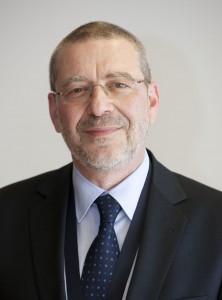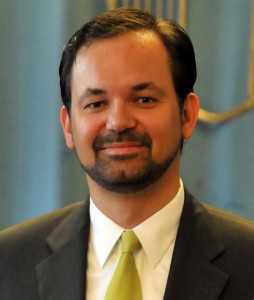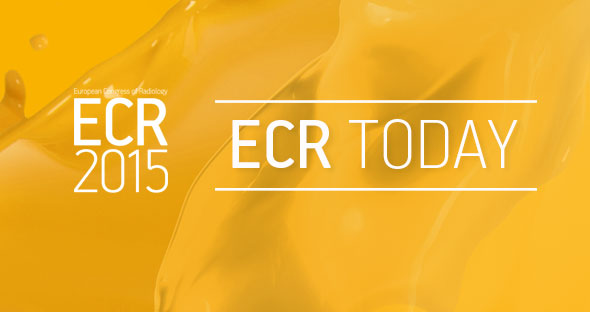Experts look into radiology’s future
Watch this session on ECR Live: Thursday, March 5, 8:00–10:00, Room E2
Tweet #ECR2015E2 #PC5A
Radiology is changing. Its possibilities are expanding; its place in healthcare has evolved. However, it has also become more vulnerable to financial turmoil. The future of the profession will depend on how radiologists decide to act and how well they can cope with external factors, a panel of experts will explain during today’s Professional Challenges Session at the ECR.

Prof. Gabriel Krestin,
from Erasmus MC,
University Medical Center
Rotterdam, will
speak about upcoming challenges
for radiologists in today’s session.
The emergence of quantitative imaging and the development of imaging biomarkers are transforming the face of radiology. An increasing number of biomarkers are being validated and accepted as measures for prognosis, diagnosis or therapy monitoring. The transition from research to clinical practice has started in many areas, and clinical radiologists have become aware of this evolution. They must learn how to use these new tools, but it is tempting to resist change, especially when it brings extra work, according to Prof. Gabriel Krestin, professor and chairman of the department of radiology at Erasmus MC, University Medical Center Rotterdam, the Netherlands.
“Radiologists don’t like to perform measurements in daily practice because they are not used to it. They haven’t been trained for that and it’s time consuming. For instance, if you do a cardiac examination, extracting quantitative data from that examination takes up to 30 minutes, so you need dedicated personnel to do that – preferably radiographers. The workflow of the radiologist could be seriously disrupted if he/she had to perform such extensive post-processing of images, and the consequence would be a decrease in efficiency, particularly because nobody pays for the additional measurements,” he said.
A number of biomarkers are already used in clinical practice, such as the RECIST criteria for the follow-up of malignant lesions under treatment. However simple they may be, even these measurements are
still not always performed in daily routine.
Emphasis must therefore be put on training, to convince radiologists of the importance of these measurements. Radiologists must also move from the traditional subjective description of findings to an objective description and measurement, in order to give precise diagnosis and advice to clinicians in terms of prognosis, monitoring and follow-up.
Plenty of imaging biomarkers are currently in development: biomarkers for vascular disease to evaluate the degree of stenosis and volumes of white matter brain lesions (or lesions in the hippocampus for the prediction of Alzheimer’s disease) for cerebrovascular disease. In the United States, the Quantitative Imaging Biomarkers Alliance (QIBA), an initiative for quantitative imaging, offers a whole list of biomarkers currently under validation.
“It is urgent for radiologists to become aware of biomarkers’ added value,” Krestin insisted. “It’s an ongoing process, and it’s extremely important for radiology in order to play a key role in what we today call ‘precision medicine’.”
Another new concept radiologists must get to grips with is integrated diagnostics. There are plenty of biomarkers to characterise a disease or decide upon its therapy and follow-up: genetic, physiological, biochemical, etc. Other medical specialties have actually been using them for a while, and imaging biomarkers are just catching up.
Consequently, physicians are starting to think that these biomarkers should be integrated into a single diagnostic report. “Pathology, laboratory medicine and imaging will come closer together to deliver an integrated answer to a clinical question based on different types of biomarkers. This would avoid a long process and increase efficiency
and effectiveness,” Krestin explained.
It is not yet clear who should take the lead in writing such a report. Krestin suggested it should be a joint effort between all the specialties involved. Applying the best from different fields would speed up the diagnostic process compared with the step-wise approach currently in place. It would make things easier for the referring clinician and benefit the patient. But the solutions for such integration have yet to be
developed.
“We will need to have supporting IT solutions to answer the clinical request together. When the referring clinician asks a question about a suspected diagnosis, when he/she wants a prognostic indication for a certain disease, or needs to know if a treatment is working, there should be a central entry point to the integrated diagnostic process. Subsequently, a combination of the most appropriate biomarkers will be determined, providing the most accurate answer in one single step. The IT solutions for such an integrated process do not exist yet, but this is the future, it would be a great benefit for healthcare and the patient,” Krestin said.
Another major change radiology has gone through recently is the ability to outsource its services. Teleradiology has brought along considerable advantages – providing an expert’s point of view when needed or offering diagnosis in the absence of a radiologist – but it has also led to abuses. Some hospitals work entirely with teleradiologists to save money, neglecting the consulting aspect of radiology and commoditising the specialty. In the process, they have exposed radiology to a great danger, according to Prof. Michael Fuchsjäger, chairman of general radiology at Graz Medical University, Austria, who will co-chair the session.

Prof. Michael Fuchsjäger, from Graz Medical University, Austria,
will chair today’s session on the
future of radiology.
“The commoditisation of our services is really an issue and a threat. In this system, radiology is considered a technical rather than a clinical specialty. In the last two to three decades, radiology has become digitised, and a perception that we are working behind our screens in a dark and quiet room and don’t want to be annoyed by clinical questions has been created, which is highly detrimental to our profession. Some may have found a very safe niche here, working a nine-to-five job, but of course this is not who we are. We are consultants; we are here for problem solving. In interdisciplinary tumour boards for example, radiology should always be present – actually it is imposed by law in some European countries – to provide the diagnostic clues that help physicians decide on how to manage the patient. We can also learn a lot from these clinical rounds. Nowadays, we call ourselves clinical radiology because
we work closely with the patients and referring physicians,” he said.
To counter this damaging perception, radiologists have to be visible. They have to be active in discussions, clinical meetings and multidisciplinary meetings, but also in their interaction with the patient, especially
before or after imaging and treatment, Fuchsjäger suggested. “You need to have your own view of the patient. You can’t just sit in the dark room; you need to communicate and interact,” he said.
Mentalities have started to change, but leaders must continue to raise the awareness of each and every radiologist. “It has become more and more obvious over the past ten years. Through the advent of all these teleradiology services and outsourcing, radiologists became aware that they would become marginalised or bypassed in the healthcare system
and that they have to show their added value, which is definitely their expertise and consulting activities. It’s a shift that’s already happening but we should put an emphasis on it, and radiology education should push that more,” Krestin said.
Adapting to changes will definitely improve their future prospects, but radiologists should bear in mind that they also depend on external factors. The session will shed a light on economic issues, which have a tremendous influence on radiology – probably more than on any other medical specialty.
“The economy affects us in a tougher and more direct way than other medical specialties, because we are dependent on machines and technologies. Part of this equipment is very expensive, for instance some scanners cost up to two million euros. A university hospital can afford that, but not a small facility. Let’s hope the euro doesn’t devalue
further,” Fuchsjäger said.
Professional Challenges Session
Thursday, March 5, 08:30–10:00, Room E2
#ECR2015E2 #PC5a
PC 5a Looking into the future of radiology
» Chairmen’s introduction
M.H. Fuchsjäger; Graz/AT
G. Paulo; Coimbra/PT
» Health technology assessment (HTA)
E.J. Adam; London/UK
» The influence of health economics systems on radiology
D. Katsifarakis; Athens/GR
» Quo vadis radiology professions? A pragmatic approach
G.P. Krestin; Rotterdam/NL
» Panel discussion: What is the role of European



I’m sure radiology will be changing a lot in the future. Diagnostic reports will change a as a result, like you said. That will mean there will be different approaches for treatments that might not be developed yet.